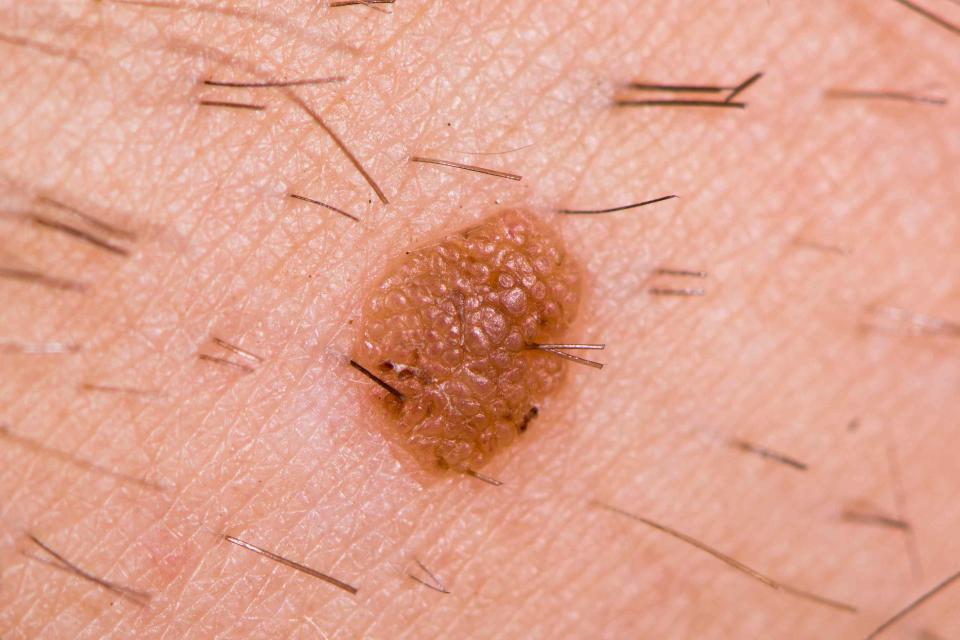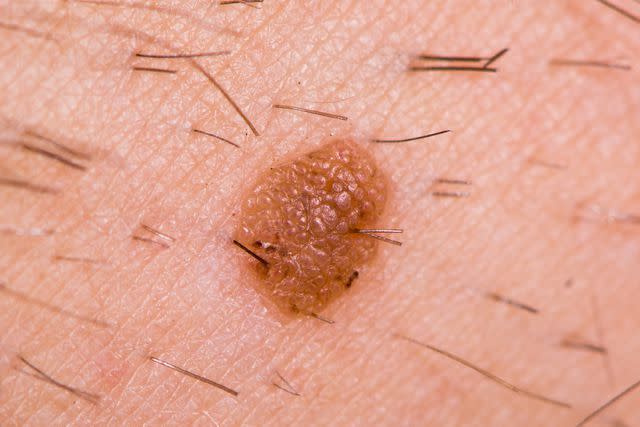Types of Seborrheic Keratosis Treatment
Surgical treatment for multiple lesions may be better than topicals alone

Ian_Redding / Getty Images
Medically reviewed by Susan Bard, MD
Seborrheic keratosis treatment is often not needed. These wartlike growths, also called skin barnacles or barnacles of aging, are harmless. Many people choose to have them removed to relieve symptoms or improve the way they look.
While these bumps are benign (noncancerous), they can itch, bleed, and may cause you to have concerns about the way you look. Treating them can make them go away, though they can recur elsewhere.
Choosing the right treatment can be a challenge. Treatments like cryotherapy and shave excision produce the best results, though they have risks of side effects. Topical treatments can help but may take time and produce fewer results.
This article describes seborrheic keratosis treatments and their success in ridding your skin of these growths.

Ian_Redding / Getty Images
Goal of Seborrheic Keratosis Treatment
The goal of seborrheic keratosis treatment is usually not related to medical treatment. The primary purpose of removing skin barnacles typically involves the following:
Remove visible signs of the disease for cosmetic reasons.
Reduce bothersome symptoms, especially pruritus (itching) and erythema (skin redness).
Remove growths that are easily irritated by clothing and jewelry.
Extract a sample for skin cancer testing.
Some growths that occur with seborrheic keratosis can look like a precancerous lesion called actinic keratosis or cancerous conditions like basal cell carcinoma and melanoma. In these cases, your dermatologist will perform a skin biopsy by shaving or scraping off skin cells from the growth. The skin cells will be analyzed under a microscope for the presence of cancer.
Since it's not known what causes seborrheic keratosis, there is no way to completely prevent the development of these growths. Research indicates they are not related to hygiene. Instead, they may be linked to factors including genetics, exposure, and changes in estrogen levels.
Learn More: Common Skin Growths
Seborrheic Keratosis Topical Treatment
Seborrheic keratosis topical treatments provide noninvasive options for the removal of growths caused by this condition.
These treatments yield different responses, though they typically do not achieve the results reported with cryosurgery. While studies on topical treatments are limited, research shows they may trigger minor local skin reactions like redness or swelling.
A review of the most commonly used topical therapies for seborrheic keratosis reported the following results:
A good to excellent response from the following topical treatments:
Maxacalcitol (vitamin D3 analogue ointment)
Tazorac (tazarotene 0.1% cream) twice daily
Doxium (5% potassium dobesilate)
URE-K 50% (urea 50% cream)
Nitric-zinc 30%-50% solution
Trichloroacetic acid
Alpha hydroxy acid (AHA) products, including glycolic acid and salicylic acid peels
Poor response was reported from the application of the following topical treatments:
Tacalcitol (vitamin D3 analog ointment)
Tazorac (tazarotene 0.1% cream) once daily
Lac-Hydrin (12% ammonium lactate cream)
Picato (ingenol mebutate 0.05% cream)
For the best results, consult your dermatologist for a diagnosis of any skin growth and advice on how to get rid of seborrheic keratosis using topical treatments.
Eskata (40% hydrogen peroxide) Discontinued
Eskata (40% hydrogen peroxide) was the first Food and Drug Administration (FDA)–approved topical treatment for seborrheic keratosis. Despite offering a promising balance between efficacy and side effects, Eskata was discontinued for distribution in the United States due to insufficient market acceptance by physicians and patients.
Seborrheic Keratosis Surgical Treatment
Seborrheic keratosis surgical treatments are safe and effective options for removing skin barnacles. Surgical treatments typically work faster than topical therapies, but they have a higher risk of side effects.
Cryotherapy
Cryotherapy is the most frequent and effective treatment for freezing seborrheic keratosis. It involves a treatment in which an extremely cold substance like liquid nitrogen or carbon dioxide is applied to the growth to freeze it off the body. The growth falls off within a few days of treatment.
While effective in removing seborrheic keratosis with little risk of scarring or recurrence, cryotherapy can include the following side effects:
Erythema
Discomfort
Bulla (large fluid-filled blisters) formation
Post-procedure hyperpigmentation (dark areas of the skin) where the growth was removed
Electrodesiccation/Curettage
Electrodesiccation is a treatment in which an electrical current is applied to the growth to remove it. It may be used with or without curettage (a procedure that uses a surgical tool called a curette to scrape the remains of the growth). These procedures may also be used alone.
Electrodesiccation with or without curettage has low complication rates, though there is a low risk of side effects like erythema, scaling, and hyperpigmentation.
Shave Excision
Shave excision uses a special exfoliating blade or double-edged razor blade to remove a growth and save a sample for examination under a microscope. The process leaves the deep layers of the skin intact. Local anesthesia is used.
Shave excision can involve complications like wound infection and bleeding. Damage to other structures like nerves and vessels is rare but possible. Scarring with or without hypopigmentation (lighter skin at the treatment site) or hyperpigmentation is also possible.
Laser Therapy
Laser therapy uses light from a laser to destroy the growth and seal the wound. The two types of laser therapy can be used to treat seborrheic keratosis are:
Ablative laser therapy: Er:YAG (erbium-doped yttrium aluminum garnet) and CO2 lasers
Non-ablative therapy: 755-nanometer (nm) alexandrite laser
Treatment with the Er: YAG laser causes less hyperpigmentation than cryotherapy and a lower recurrence rate than shaving. It has very good cosmetic results. However, laser therapy is more expensive than other treatments.
Does Seborrheic Keratosis Come Back After Treatment?
Seborrheic keratosis is a chronic, relapsing skin condition. The prognosis for someone treated for seborrheic keratosis is very good. While most removed seborrheic keratoses do not return, new ones can develop elsewhere.
A seborrheic keratosis that recurs in the same location after treatment usually requires a skin biopsy (removing a sample of skin for analysis in a lab). This is to ensure that the original diagnosis was correct and rule out the presence of cancer.
Seborrheic Keratosis vs. Cancerous Spots
The discolored growths that occur with seborrheic keratosis can appear similar to cancerous spots from conditions like melanoma or basal cell carcinoma. A skin biopsy can help your dermatologist make a definitive diagnosis. These conditions vary in the following ways:
Seborrheic keratosis:
Often appear as multiple growths
Bumpy texture
Well-defined border
Uniform in color
Changes slowly
Cancerous spots:
Usually appears as one growth
Often smooth
Ragged or blurry border
Asymmetrical and/or multiple colors
Changes quickly in shape and size
Daily Skin Care With Seborrheic Keratosis
Skin affected by seborrheic keratosis is easily irritated. Irritations can cause the condition to flare. You can help reduce flares with the following daily skin-care strategies.
Cover your seborrheic keratosis growth with a bandage to prevent rubbing and bleeding if clothing irritates it.
After seborrheic keratosis removal, follow the instructions from your healthcare provider. This usually involves the following:
Avoid hydrogen peroxide or alcohol since they can interfere with healing.
Cover the wound with a thin layer of petroleum jelly and a nonstick bandage until it heals.
Contact your healthcare provider if you notice the following:
A mole that bleeds
A crusted or scaly growth on your skin
A fast-growing mole
A sore that does not heal
A change in the appearance of a skin growth
A new growth that has ragged borders and irregular color
New itchiness in an existing mole
Home Remedies/Drug-Free Treatments
There are no proven home remedies for seborrheic keratosis removal. Products marketed for mole removal or home remedies like apple cider vinegar or tea tree oil tend to cause more irritation and can increase the risk of scarring.
Do not try to remove seborrheic keratosis at home. Doing so can be dangerous because the growth may be something more serious. It also presents a risk of infection.
Summary
Seborrheic keratosis can usually be left alone without treatment. While these benign skin growths can look like cancer, they are viewed as harmless and rarely present a health concern.
However, having them can pose problems. These growths can become itchy and bleed. They can also affect the way you look and the way you feel about yourself.
Safe and effective treatments exist, though most have a risk of side effects. Scarring, discoloration, and redness at the treated site can occur. Even when a cure succeeds, there is always a risk that another growth will occur elsewhere from this chronic problem.
If removing these growths is right for you, consult your dermatologist for advice on choosing the treatment that is best.

